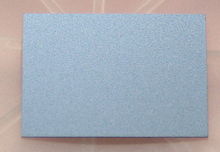
| |

| |
| Names | |
|---|---|
| Other names
Indium(III) phosphide
| |
| Identifiers | |
3D model (JSmol)
|
|
| ChemSpider | |
| ECHA InfoCard | 100.040.856 |
PubChem CID
|
|
| UNII | |
CompTox Dashboard (EPA)
|
|
| |
| |
| Properties | |
| InP | |
| Molar mass | 145.792 g/mol |
| Appearance | black cubic crystals[1] |
| Density | 4.81 g/cm3, solid[1] |
| Melting point | 1,062 °C (1,944 °F; 1,335 K)[1] |
| Solubility | slightly soluble in acids |
| Band gap | 1.344 eV (300 K; direct) |
| Electron mobility | 5400 cm2/(V·s) (300 K) |
| Thermal conductivity | 0.68 W/(cm·K) (300 K) |
Refractive index (nD)
|
3.1 (infrared); 3.55 (632.8 nm)[2] |
| Structure | |
| Zinc blende | |
a = 5.8687 Å [3]
| |
| Tetrahedral | |
| Thermochemistry[4] | |
Heat capacity (C)
|
45.4 J/(mol·K) |
Std molar
entropy (S⦵298) |
59.8 J/(mol·K) |
Std enthalpy of
formation (ΔfH⦵298) |
-88.7 kJ/mol |
Gibbs free energy (ΔfG⦵)
|
-77.0 kJ/mol |
| Hazards | |
| Occupational safety and health (OHS/OSH): | |
Main hazards
|
Toxic, hydrolysis to phosphine |
| Safety data sheet (SDS) | External MSDS |
| Related compounds | |
Other anions
|
Indium nitride Indium arsenide Indium antimonide |
Other cations
|
Aluminium phosphide Gallium phosphide |
Related compounds
|
Indium gallium phosphide Aluminium gallium indium phosphide Gallium indium arsenide antimonide phosphide |
Except where otherwise noted, data are given for materials in their standard state (at 25 °C [77 °F], 100 kPa).
| |
Indium phosphide (InP) is a binary semiconductor composed of indium and phosphorus. It has a face-centered cubic ("zincblende") crystal structure, identical to that of GaAs and most of the III-V semiconductors.
- ^ a b c Haynes, p. 4.66
- ^ Sheng Chao, Tien; Lee, Chung Len; Lei, Tan Fu (1993), "The refractive index of InP and its oxide measured by multiple-angle incident ellipsometry", Journal of Materials Science Letters, 12 (10): 721, doi:10.1007/BF00626698, S2CID 137171633.
- ^ "Basic Parameters of InP". Ioffe Institute, Russia.
- ^ Haynes, p. 5.23